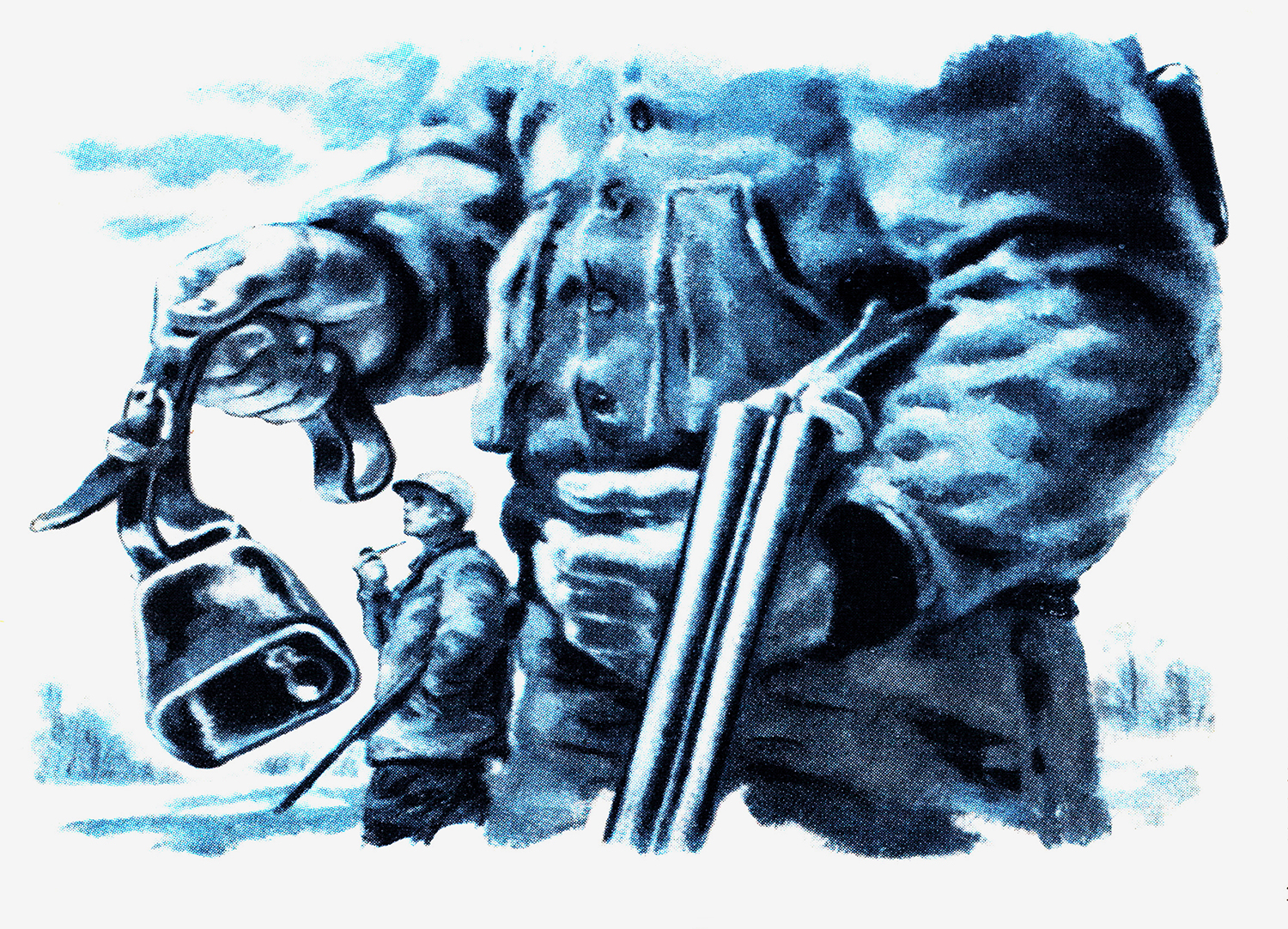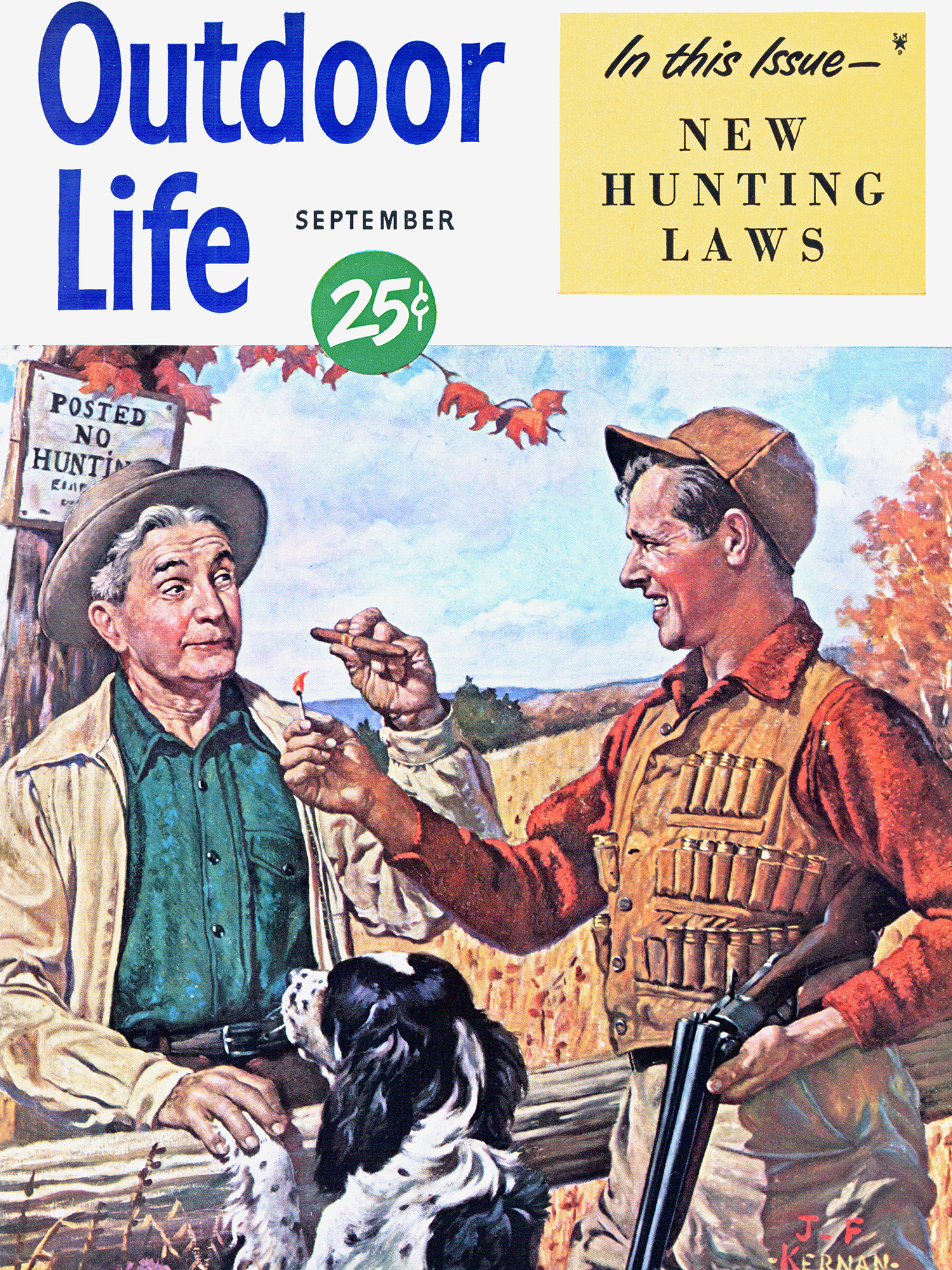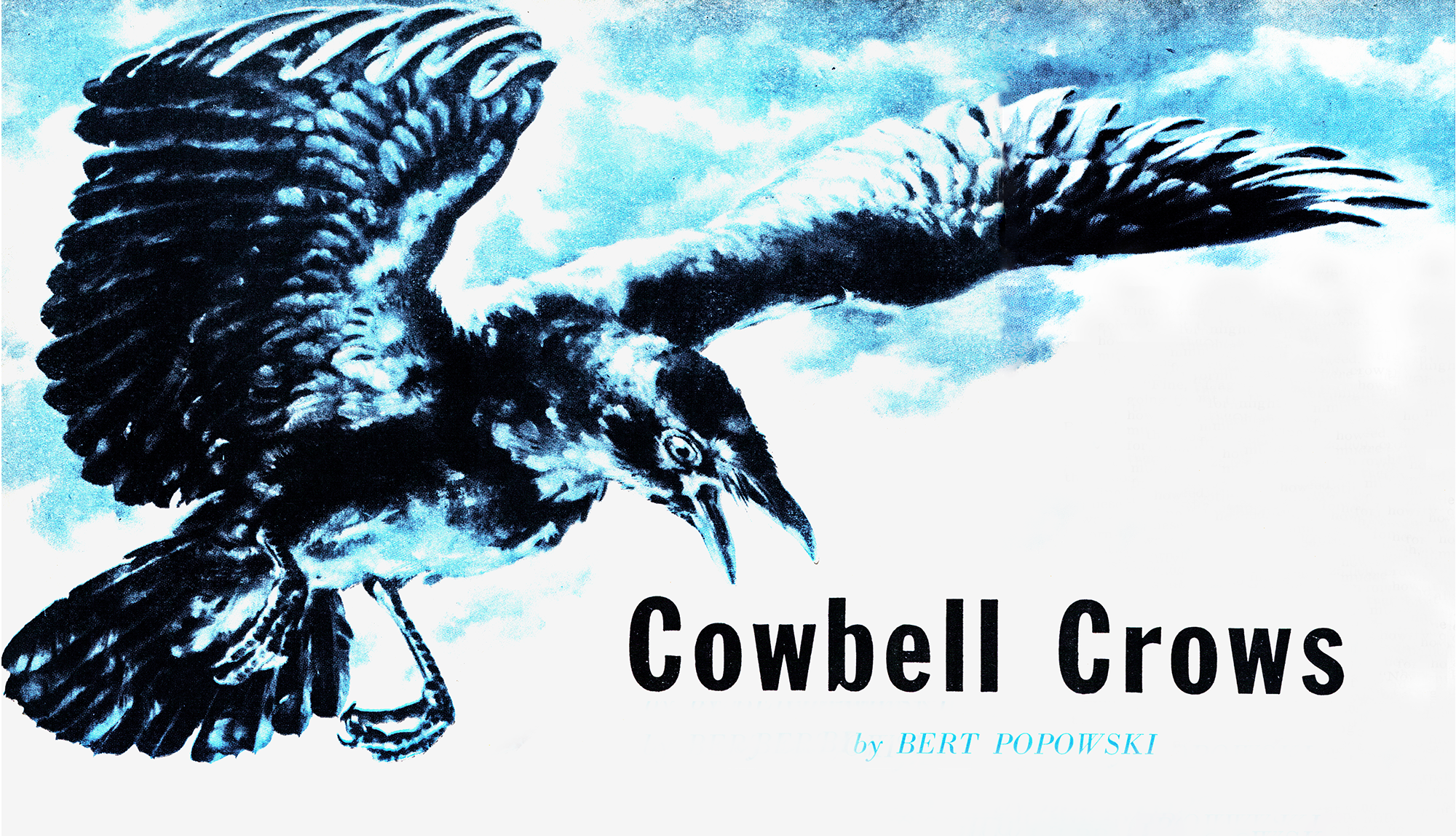THE FIRST THING Ray Johnson brought out when we started on our crow hunt was a worn and battered cowbell. I stared at the noisy contraption, for the only Ohio crow hunting I’d done in Ray’s company was of the stop-and-go variety: stop at a likely-looking bit of timber, call in and kill as many of the answering crows as possible, and then drift on down the road for a repeat performance at the next good spot.
Ray gave the bell an extra jangle as he tossed it into the car. Then he stowed away his gun, shells, a couple of burlap sacks, and some lengths of stout cord. All these were standard items of crow-hunting equipment. But that cowbell was something else!
“What’s the idea?” I demanded, shuddering at the brassy clamor that broke out anew as I hefted it.
Ray grinned. “The crows around here are mighty leery of men walking through the brush, especially now that the gamebird season is over. But they’re used to cattle, so they relax when they hear a cowbell.”
I choked on that one, and Ray took me up fast.
“Wait until you see it in action. If it doesn’t work, then you can have your laugh.”
Ray drove until we neared the Indiana state line, turned off on a black-top road, and went along the edge of a flat valley that held the gray flood of the Miami River. The wide, muddy flats looked good, for it is in just such spots that crows congregate for a spot of squabbling, and a final snack, before setting out on the last lap of flight toward their roost. I approved the spot and said so.

“The best part of it is that their roost is at the far edge of that strip of timber, right on the edge of the river,” Ray told me. “You can’t see the channel now, with all this flood water, but I’ll bet there are 25,000 crows using that roost.”
“Fine,” I agreed. “But how are you going to get there? And after you do, how will you build a blind on that muddy footing? Crow shooting calls for mighty quick turns.”
“Oh, we’re not hunting there today. These crows don’t like to roost over water any more than the crows in the corn-belt regions where you’ve been hunting—especially with this cold wind crossing the water. Today we’ll hunt them in the ridges. From there we’ll be able to keep an eye on them as they come in. Later, when the water goes down, we’ll set up right at the edge of the roost.”
That made sense to me. What could be nicer than having one crow-shooting session while keeping an eye on the site of a later one, and on the birds that were to furnish the fireworks?
We unloaded at the foot of the ridge and Ray took the car on some 200 yards, into a farmyard where it would be less conspicuous. We packed about 100 pounds of assorted equipment up that steep slope and in about an hour had a grapevine-and-weed blind snugged into the lee of the ridge.
Mighty Natural Decoys
It was none too soon, for a pair of crows came wheeling in while I was snicking loads into my pet Ithaca. We dropped to our knees, I cut loose with the call, and those two birds slanted down toward us as if tied to strings. When they were thirty yards away we rose in their faces, and both birds tumbled in a fine flurry of their own feathers.
“All with nary a cowbell,” I crowed. “Now I’ll show you something.”
I tied that pair of crows with slipknots at the ends of a two-foot length of cord and then secured the end of a spool of thin black cord to one of them. On the third throw I lodged them in the top of a twenty-foot elm. There the dead birds swung to the thrust of the breeze that leaked over the top of the ridge, the most natural decoys we could find.
The next pair of crows came in cautiously until I tugged at the black line leading to our decoys, simultaneously cutting loose with the call. One of the carcasses jerked crazily, and those incomers could literally see, and hear, that it was a friend in trouble. Their suspicions allayed, they folded their wings and came diving down. So all-out was their descent that we had to jump up in their startled faces. If we hadn’t, they’d have dropped in so close that our shotguns would have to be aimed with rifle accuracy to score clean kills. Even so, it took three shots before we had the materials for another pair of decoys. We hung these in the same tree as the first pair.
“Wouldn’t it be better if we scattered them?” Ray wanted to know.
“Not while we’re jerking one decoy to make it look like a bird in trouble,” I answered. “Crows are such gangsters that when something is bothering one of them the rest all huddle around. So it’s bad strategy to put the other decoys too far away from the one that’s being jerked, because then it looks as if they were afraid of whatever is causing the trouble.”
For better than an hour we had our fun with incoming pairs and small family groups. After that the birds started arriving in larger flocks, and that’s when Ray’s cowbell strutted its stuff. While I called, and intermittently gave the black string a tug, he worked the cowbell in a smooth, rhythmic swing—giving it the lazy, measured cadence of a well-fed and contented bossy plodding home from pasture.
When birds came in, we’d give the raucous yell of a crow in distress—as if some crow behind us had suddenly come upon crowdom’s dread enemy, a great horned owl. Those newcomers couldn’t pour on the coal fast enough in their effort to join in the gang attack!
The flight line had been veering away from our half-dozen pairs of decoys, but now it turned back to cross over our blind and the noisy cowbell. Out of this flight we kept cutting pairs and threes; once we caught a small flock just right and each of us got a double.
“I stumbled on the idea when some of the local farmers asked me out for a moonlight shoot,” Ray told me later. “There was snow on the ground, and the moon was bright enough so the crows could see us coming. But one farmer carried a cowbell. Those birds thought we were cattle and let us walk right into them.”
“And the next day the roost had moved elsewhere,” I commented dryly. “One session like that and your roost is burned out.”
“It sure was, and it cured me of night shooting. I’d rather set up a blind and get them in one of the flyways over these ridges, or on the leeward side of the roost, up to a quarter of a mile away.”
It was nearly two weeks later that Ray called me for a shoot in the river bottoms. The flood waters had receded into the Miami’s channel, and a cold snap had frozen a solid crust on the silt deposited on the surrounding cornfields.
“You ought to see the crows in that flat,” Ray told me, his voice high. “They cover those fields like a blanket. They’re feeding on the waste corn that was softened by that flood water. There’s a cold snap predicted for tonight. That, with this rising wind, ought to bring them in early.”
“That’s fine, but don’t bring the cowbell,” I warned. “We won’t be flyway shooting this time. Besides, crows are smart enough to know that no sensible cattle would be wandering around that soft river bottom. Just have a boat ready to take us across the channel to the roost. I’ll do the rest.”
“What do you have in mind?” asked Ray. But I just mumbled that I’d bring along the essentials, and hung up on him.
A couple of hours later three of us were out at the river bottom: Ray Johnson, Ray Weesner, and I. One lone crow sat atop a cottonwood and watched us, from a healthy 200 yards away. That is, he watched us carefully until I chambered a single shell and fired it. Then he lifted off his perch and winged lazily away to the far side of the flat, half a mile away.
“What did you waste that shell for?” Johnson demanded.
“That bird’s an old settler, and a smart one. If we’d let him watch us go into the roost and build our blinds, he’d gossip about it until half the crows would know all about us.”
We piled our equipment into the boat and pulled into the sluggish current, letting it carry us downstream some 200 yards to land in the lee of the roost. After we unloaded there, Johnson took the boat back upstream and pulled it ashore into the brush while Weesner and I prospected the roost in detail.
Sure enough, it was spattered everywhere with the whitewashy “spit” that characterizes the birds’ nocturnal hangout. There were, too, dozens of the pellets the birds cast up, much as an owl coughs up small balls of indigestible fur, feathers, and bones from its prey. In the case of the crows, these pellets were formed of the hulls of kernels of corn and weed seeds. Here and there was one with a distinctly reddish tinge, indicating a meat diet. Probably some traffic-killed gamebird or bunny that the birds had scavenged.
By the time Johnson got back we had the blind site picked—in a low stand of willows directly in front of a couple of fat-trunked river-bottom cottonwoods. Vegetation was scarce in the area, but I hacked off a two-inch-thick sapling and tied it chest-high between the willow shrubs. That gave us the front ridgepole for our blind. While Johnson and Weesner scouted around for armloads of weeds and brush to lean against this support, I cut a pair of ten-foot willows and tied their butts to the ends of the first sapling, with their tops pointing downwind at right angles to it. This formed a shallow, three-sided box, some eight feet long and six feet deep.
Shoot Your Own Decoys!
Weathered burlap sacks more than made up for the thin walls of the blind. Stretched taut between supporting saplings, they formed a solid screen that needed only a crisscrossing of weeds and branches to make our hide-out all but invisible from anywhere but directly overhead. And crows that looked into the blind from that direction should shortly be “good” crows, if our marksmanship was equal to the occasion.
“Looks like it’ll be a tough job to get decoys into the tops of those cottonwoods,” said Johnson, looking at the eighty-foot trees.
“All we need’s a couple of pairs halfway up,” I assured him. “The rest will be right out in front.”
“In that open, muddy stretch?” demanded Weesner.
“Yep. I’ve got the right medicine for them here,” I told him, patting a bulging jacket pocket. “Down! Here come crows!”
And come they did—half a dozen big, burly fellows, bulging with the fine fare from neighboring farms, their feathers gleaming with health. They came straight at us with a carelessness bred of long immunity from gunfire. Even when we rose as one man they hung stupidly above us, until the guns spoke. Three birds spun down in the first blast, then two more. The survivor wobbled a bit, then slanted steeply into the Miami, raising a three-foot splash as it hit.
“Get them in here,” I said. “We need them for decoys.”
Using a pencil-thick elm twig like an ice pick, I punctured the chest of each bird, ran the twig inside the loose skin of the neck, and jabbed it sharply into the skull. Withdrawing it, I replaced it with a willow shoot. Then I reached into my jacket pocket and came up with some thin rubber bands. Two of these went around each bird, holding the wings snug to the body.
“Stick these into the mud, to look like birds that are feeding and resting,” I told the two Rays. “Scatter ’em about thirty yards out, right in front of the blind.”
They hadn’t been back but a minute or two before more crows came over the high ridge to our left. Spying our decoys, they folded their wings, falling fifty and sixty yards at a time, until they were less than a dozen feet off the ground. That’s when I hit them with a fighting call. Their lazy wings leaped into a new tempo, and in a dozen strokes they were within easy range. Four stayed and were set out with the other decoys to lure in their fellows.

Weesner goggled at the way crows fell out of the sky to join the steadily growing spread of lifelike birds we planted. Two lightly winged cripples, staked out on a short length of black fishline, gave the spread all the animation it needed. All the decoys were at least three feet apart, and the average spacing was closer to nine.
When birds came in, we let them drop just short of the last swoop before landing. Then we’d give the raucous yell of a crow in distress—just as if some crow in the brush behind us had suddenly come upon crowdom’s dread enemy, a great horned owl. Those newcomers couldn’t pour on the coal fast enough in their effort to join in the gang attack!
It lacked only an hour of twilight before I yielded to Johnson’s urging that we hang some of our decoys in the cottonwoods behind us. By this time the birds were more interested in going directly into the roost than in swooping down on the muddy flats, so the dead birds brought them more squarely across our blind.
Darkness found us fumbling around for crow carcasses—not for decoys any more, but because their heads are worth two bits apiece in Ohio bounty. At that rate, the black rascals do a nice job of paying for the shotgun shells that end their thieving careers.
Read more OL+ stories:
• This Is Why I Won’t Duck Hunt Alone Anymore, From the Archives
• Nightmare on Missinaibi Lake, a Survival Story From the Archives
